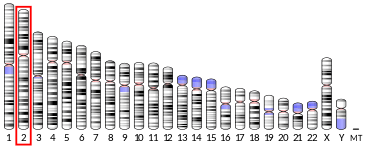TMEM127
Transmembrane protein 127 (TMEM127) is a transmembrane protein which is encoded by the TMEM127 gene.[5]. It has been demonstrated to be a negative regulator MTOR signalling.[6] TMEM127 is a tumor suppressor gene, inactivating germline mutations in which causes hereditary pheochromocytoma and paraganglioma.[6][7]
| TMEM127 | |||||||||||||||||||||||||
|---|---|---|---|---|---|---|---|---|---|---|---|---|---|---|---|---|---|---|---|---|---|---|---|---|---|
| Identifiers | |||||||||||||||||||||||||
| Aliases | TMEM127, transmembrane protein 127 | ||||||||||||||||||||||||
| External IDs | OMIM: 613403 MGI: 1916720 HomoloGene: 9877 GeneCards: TMEM127 | ||||||||||||||||||||||||
| |||||||||||||||||||||||||
| |||||||||||||||||||||||||
| |||||||||||||||||||||||||
| Orthologs | |||||||||||||||||||||||||
| Species | Human | Mouse | |||||||||||||||||||||||
| Entrez | |||||||||||||||||||||||||
| Ensembl | |||||||||||||||||||||||||
| UniProt | |||||||||||||||||||||||||
| RefSeq (mRNA) | |||||||||||||||||||||||||
| RefSeq (protein) | |||||||||||||||||||||||||
| Location (UCSC) | Chr 2: 96.25 – 96.27 Mb | Chr 2: 127.25 – 127.26 Mb | |||||||||||||||||||||||
| PubMed search | [3] | [4] | |||||||||||||||||||||||
| Wikidata | |||||||||||||||||||||||||
| |||||||||||||||||||||||||
References
- GRCh38: Ensembl release 89: ENSG00000135956 - Ensembl, May 2017
- GRCm38: Ensembl release 89: ENSMUSG00000034850 - Ensembl, May 2017
- "Human PubMed Reference:". National Center for Biotechnology Information, U.S. National Library of Medicine.
- "Mouse PubMed Reference:". National Center for Biotechnology Information, U.S. National Library of Medicine.
- "TMEM127 transmembrane protein 127 [Homo sapiens (human)] - Gene - NCBI". www.ncbi.nlm.nih.gov. Retrieved 2018-03-09.
- Qin Y, Yao L, King EE, Buddavarapu K, Lenci RE, Chocron ES, Lechleiter JD, Sass M, Aronin N, Schiavi F, Boaretto F, Opocher G, Toledo RA, Toledo SP, Stiles C, Aguiar RC, Dahia PL (March 2010). "Germline mutations in TMEM127 confer susceptibility to pheochromocytoma". Nature Genetics. 42 (3): 229–33. doi:10.1038/ng.533. PMC 2998199. PMID 20154675.
- Neumann HP, Sullivan M, Winter A, Malinoc A, Hoffmann MM, Boedeker CC, Bertz H, Walz MK, Moeller LC, Schmid KW, Eng C (August 2011). "Germline mutations of the TMEM127 gene in patients with paraganglioma of head and neck and extraadrenal abdominal sites". The Journal of Clinical Endocrinology and Metabolism. 96 (8): E1279-82. doi:10.1210/jc.2011-0114. PMID 21613359.
This article is issued from Wikipedia. The text is licensed under Creative Commons - Attribution - Sharealike. Additional terms may apply for the media files.



